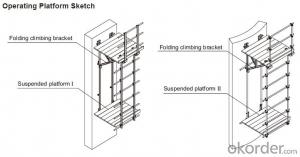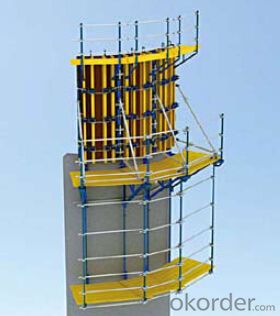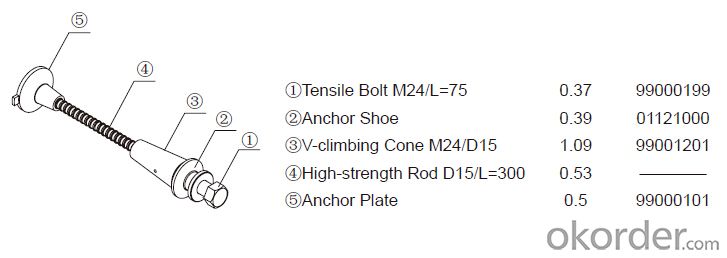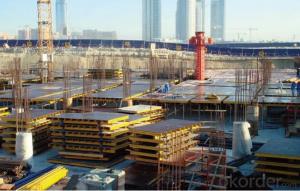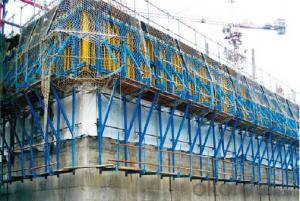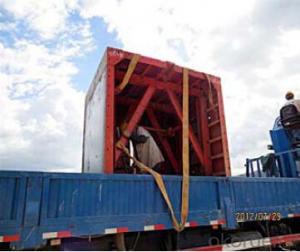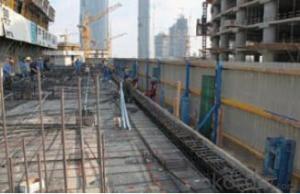Climbing Platform CP 190 for formwork and scaffolding system
- Loading Port:
- Tianjin
- Payment Terms:
- TT OR LC
- Min Order Qty:
- 50 m²
- Supply Capability:
- 1000 m²/month
OKorder Service Pledge
OKorder Financial Service
You Might Also Like
Climbing Platform CP190
Climbing bracket CP190 is mainly used as operating platform during construction. It can be used
on the vertical wall and arced wall. The bracket hang on the anchor system and all the load are
supported by anchor system. It’s convenient to assemble and dismantle, the construction is easy,
rapid and safe.
Anchor System:
Anchor system is the most important supporting part. The system is made of five parts shown
below. There into, tensile bolt, anchor shoe and V-climbing cone can be taken out for reusing.
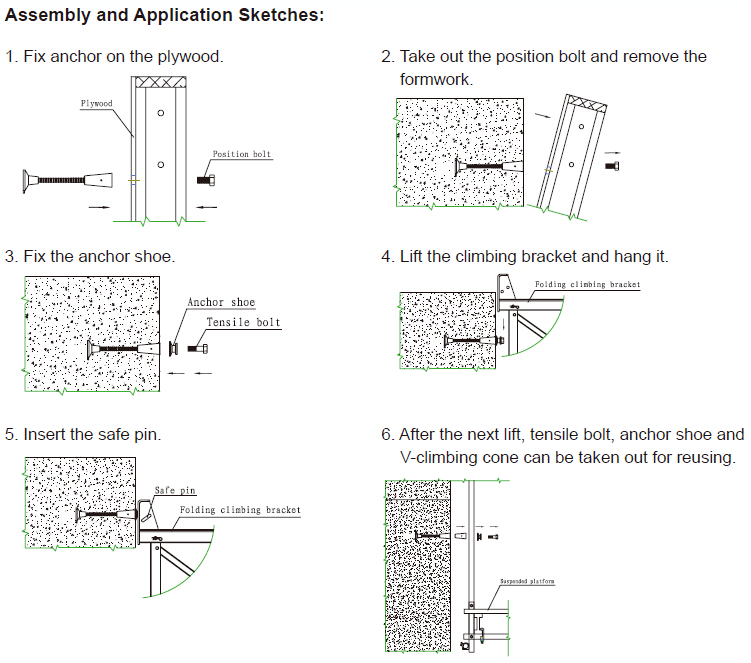
- Q: How does steel formwork affect the overall thermal performance of the structure?
- Steel formwork can have a significant impact on the overall thermal performance of a structure. The main factor that influences this is the thermal conductivity of steel. Steel has a high thermal conductivity, meaning it can easily transfer heat from one side to the other. When steel formwork is used in the construction of a building, it acts as a thermal bridge between the interior and exterior of the structure. This can result in heat transfer across the steel formwork, leading to increased heat loss or gain depending on the external temperature. In colder climates, steel formwork can contribute to higher heat loss, resulting in increased energy consumption for heating. Similarly, in warmer climates, steel formwork can allow heat to transfer into the building, leading to increased cooling requirements. To mitigate this thermal bridging effect, various measures can be taken. One approach is to use thermal breaks, which are insulating materials placed between the steel formwork and the rest of the structure. These breaks help reduce the heat transfer through the steel, improving the overall thermal performance. Another approach is to use alternative formwork materials with lower thermal conductivity, such as insulated concrete forms (ICFs) or wood. It is important to consider the thermal performance of steel formwork during the design and construction phases to ensure energy efficiency and occupant comfort. By implementing proper insulation and thermal breaks, the negative impact of steel formwork on the overall thermal performance of the structure can be minimized.
- Q: Can steel formwork be used for both vertical and horizontal applications?
- Yes, steel formwork can be used for both vertical and horizontal applications. Steel formwork is known for its versatility and strength, making it suitable for various construction projects. It can be used to create formwork for vertical elements such as walls, columns, and beams, as well as for horizontal elements like slabs and foundations. The rigid nature of steel formwork allows for precise shaping and ensures that the concrete is held in place securely during the pouring and curing process. Additionally, steel formwork is reusable, which makes it a cost-effective choice for construction projects that require frequent formwork changes or repetitive use.
- Q: What are the different material handling requirements for steel formwork?
- Steel formwork offers numerous advantages in construction projects, such as its durability, reusability, and ability to withstand high pressure and loads. However, it is important to consider specific material handling requirements associated with steel formwork. Firstly, when handling and transporting steel formwork panels, it is crucial to use suitable lifting equipment like cranes or forklifts. This ensures that the load is evenly distributed and reduces the risk of dropping or damaging the panels during transportation. Secondly, proper storage is essential to prevent rust and corrosion. The panels should be stored in a dry and well-ventilated area. Additionally, they should be stacked evenly to avoid deformation. It is important to stack them in a way that allows easy access to individual panels without causing damage to others. Regular cleaning and maintenance are necessary to ensure the longevity and reusability of steel formwork. After each use, the formwork should be cleaned to remove any concrete residue, dirt, or debris. Additionally, it is important to inspect the formwork for any signs of damage, such as cracks or bends, and repair or replace them as needed. Skilled workers are required for the proper assembly and disassembly of steel formwork. The panels need to be accurately aligned and securely connected to form a watertight structure. During disassembly, care should be taken to avoid damaging the panels, ensuring they can be reused in the future. To enhance the durability and lifespan of steel formwork, surface protection measures should be taken. This includes applying anti-corrosion coatings or paint to prevent rust and corrosion. Regular inspections should be conducted to identify any signs of damage or deterioration on the surface, and necessary actions should be taken to maintain the integrity of the formwork. In conclusion, adhering to the material handling requirements for steel formwork, such as proper handling and transportation methods, appropriate storage and stacking, regular cleaning and maintenance, skilled assembly and disassembly, and surface protection measures, is essential for optimal performance and longevity in construction projects.
- Q: Can steel formwork be used for bridge piers?
- Bridge piers can indeed utilize steel formwork. This alternative is incredibly adaptable and long-lasting, making it appropriate for constructing a wide range of structures, including bridge piers. It presents several benefits, such as exceptional strength, effortless assembly and disassembly, and the ability to accommodate various designs. By employing steel formwork, one can accurately shape and reinforce bridge piers, guaranteeing their structural soundness and stability. Moreover, steel formwork can withstand the immense loads and pressures that bridge piers encounter throughout their existence. Consequently, steel formwork is a dependable and widely employed option when constructing bridge piers.
- Q: How does steel formwork handle concrete finishing and curing agents?
- Steel formwork, a material specifically designed for concrete finishing and curing, is highly durable and versatile. Its strength and rigidity ensure a stable structure for controlled pouring and curing of concrete. During the concrete finishing stage, steel formwork allows for the smooth and even application of various finishing agents like troweling, brushing, or spraying. The smooth surface of steel formwork facilitates easy application and manipulation of these agents, resulting in a uniform and aesthetically pleasing finish. Furthermore, steel formwork is resistant to chemical reactions with concrete curing agents. These curing agents, such as sealers, compounds, or coatings, enhance the strength, durability, and appearance of freshly poured concrete. Steel formwork's non-reactive nature allows for the application and absorption of these agents by the concrete without any negative impact on the formwork material. Moreover, steel formwork is non-absorbent, meaning it does not soak up moisture from curing agents or the concrete itself. This characteristic is vital during the curing process as it allows the concrete to maintain its moisture content, ensuring proper hydration and strength development. Additionally, the non-absorbent nature of steel formwork prevents potential damage or degradation that could arise from moisture absorption, expansion, or corrosion. In conclusion, steel formwork is an excellent choice for handling concrete finishing and curing agents due to its strength, rigidity, non-reactive nature, and non-absorbent properties. It provides a stable structure for applying finishing agents while supporting proper curing and moisture retention in the concrete.
- Q: Can steel formwork be used for both reinforced and non-reinforced concrete structures?
- Absolutely! Steel formwork is applicable to both reinforced and non-reinforced concrete structures. This flexible and long-lasting choice can endure the immense pressure generated by the concrete during pouring. Moreover, it can be effortlessly put together and taken apart, making it ideal for diverse construction undertakings. Whether it's a reinforced structure necessitating supplementary reinforcement bar support or a non-reinforced structure requiring a temporary mold, steel formwork proves effective in either scenario. Its robustness and steadiness enable the achievement of accurate shapes and measurements, guaranteeing the desired result for any concrete structure.
- Q: How does steel formwork compare to other types of formwork in terms of durability?
- Steel formwork is known for its exceptional durability compared to other types of formwork. Unlike wooden or plastic formwork, steel formwork is built to withstand heavy loads and repetitive use, making it ideal for projects that require long-term usability. Steel formwork is not affected by weather conditions, moisture, or decay, making it highly resistant to damage and deterioration. It can withstand extreme temperatures, strong winds, and heavy rains without compromising its structural integrity. This durability ensures that steel formwork can be used in various construction projects, including high-rise buildings, bridges, and tunnels, where strength and reliability are crucial. Another advantage of steel formwork is its ability to bear high concrete pressures. The robustness of steel allows it to handle the pressure exerted by wet concrete during the pouring and curing process. This makes steel formwork highly suitable for projects that involve pouring large volumes of concrete, ensuring that the formwork remains intact and can be reused multiple times. Furthermore, steel formwork has a longer lifespan compared to other materials. Due to its durability, it can be used for multiple construction cycles, reducing the need for frequent replacements. This not only saves time and money but also minimizes waste generated during construction. In summary, steel formwork surpasses other types of formwork in terms of durability. Its resistance to weather conditions, high concrete pressures, and long lifespan make it a reliable choice for construction projects that require a strong and long-lasting formwork system.
- Q: How does steel formwork contribute to the overall cost-effectiveness of the construction process?
- Steel formwork contributes to the overall cost-effectiveness of the construction process in several ways. Firstly, steel formwork is highly durable and can be reused multiple times, reducing the need for frequent replacements and lowering the overall material costs. This durability also leads to reduced maintenance and repair expenses, further enhancing the cost-effectiveness. Secondly, steel formwork offers excellent dimensional stability, ensuring that the concrete structures are built with precision and accuracy. This results in reduced wastage of materials, as the formwork provides a reliable template for the desired shape and size of the concrete elements. Minimizing material wastage directly contributes to cost savings. Moreover, steel formwork provides faster construction cycles due to its ease of assembly and disassembly. The interlocking panels and adjustable features make it quick and efficient to set up, saving valuable time and labor costs. The seamless integration of steel formwork with modern construction techniques, such as mechanized systems, further enhances productivity and reduces construction time. Furthermore, steel formwork offers flexibility and adaptability, allowing for customization and adjustments as per project requirements. It can be easily modified to accommodate changes in design or specifications, reducing the need for additional formwork or costly modifications. This adaptability enhances cost-effectiveness by avoiding unnecessary expenses. Additionally, steel formwork is known for its high strength and load-bearing capacity, enabling it to withstand heavy loads and provide a safe working environment. This strength eliminates the need for additional support structures, reducing the overall material and labor costs. Overall, the use of steel formwork in the construction process contributes to cost-effectiveness through its durability, reduced material wastage, faster construction cycles, flexibility, and strength. By optimizing resources and enhancing efficiency, steel formwork helps to minimize expenses, making it a cost-effective choice in construction projects.
- Q: What are the considerations when designing steel formwork for industrial facilities?
- When designing steel formwork for industrial facilities, there are several important considerations that need to be taken into account. These considerations include: 1. Load-bearing capacity: Industrial facilities often house heavy machinery and equipment, so the steel formwork needs to be designed to withstand the weight and load placed on it. The formwork should be able to support the weight of the machinery while ensuring structural stability and safety. 2. Durability: Steel formwork should be able to withstand the harsh conditions often found in industrial facilities, such as temperature fluctuations, exposure to chemicals or corrosive substances, and heavy usage. It should be designed to have a long lifespan and require minimal maintenance to ensure cost-effectiveness. 3. Flexibility and adaptability: Industrial facilities often undergo changes, upgrades, or modifications over time. Therefore, the steel formwork should be designed to be flexible and adaptable, allowing for easy modifications or additions as required. This includes considering factors such as future expansion, reconfiguration, or relocation of machinery or equipment. 4. Safety: Safety is a crucial consideration when designing steel formwork for industrial facilities. The formwork should be designed to prevent accidents or injuries, such as by incorporating safety features like guardrails, non-slip surfaces, or adequate lighting. It should also adhere to relevant safety codes and standards to ensure compliance. 5. Ease of construction and dismantling: Steel formwork should be designed to be easily assembled and disassembled. This will not only save time during construction but also allow for efficient reusability of the formwork in future projects. Considerations like modular designs or prefabricated components can facilitate easier construction and dismantling processes. 6. Cost-effectiveness: Designing steel formwork for industrial facilities should also take into account cost-effectiveness. This includes optimizing material usage, minimizing waste, and considering the long-term maintenance and operational costs. Balancing the initial investment with the expected lifespan and benefits of the formwork is essential to achieve the most cost-effective solution. Overall, designing steel formwork for industrial facilities requires careful consideration of load-bearing capacity, durability, flexibility, safety, ease of construction, and cost-effectiveness. By addressing these considerations, designers can ensure that the formwork meets the specific requirements of industrial applications and provides a reliable and efficient solution for construction projects.
- Q: Can steel formwork be used for industrial flooring?
- Indeed, industrial flooring can be constructed using steel formwork. Renowned for its robustness and resilience, steel formwork proves to be well-suited for demanding tasks, particularly in heavy-duty applications like industrial flooring. It possesses the ability to withstand the substantial weight and pressure imposed by heavy machinery and equipment, presenting a reliable and firm foundation for industrial operations. Moreover, steel formwork boasts the added benefit of reusability, rendering it a financially prudent option for industrial flooring.
Send your message to us
Climbing Platform CP 190 for formwork and scaffolding system
- Loading Port:
- Tianjin
- Payment Terms:
- TT OR LC
- Min Order Qty:
- 50 m²
- Supply Capability:
- 1000 m²/month
OKorder Service Pledge
OKorder Financial Service
Similar products
Hot products
Hot Searches
Related keywords


